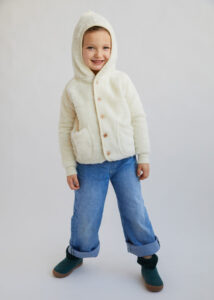Fleece jackets and hoodies have become a staple of our fall and winter wardrobes, popularized by outdoor brands like Patagonia. These cozy, fuzzy layers are designed to feel soft and wooly to the touch. But very few fleece hoodies are actually made from wool. The vast majority are made from plastic fibers, like polyester.
Caroline Priebe, a sustainable fashion designer, wants to make a better fleece. She’s just launched a company called Driftless Goods that makes hoodies from regenerative merino wool sourced from American farmers. At $275, Driftless hoodies are roughly double the cost of Patagonia’s, but Priebe believes that there are sustainably minded consumers who are eager for garments that aren’t actively polluting the planet. The hoodies are currently available for preorder and will ship in the fall.
Priebe has spent 20 years helping brands and retailers become more sustainable through her company, the Center for the Advancement of Garment Manufacturing. She’s helped everyone from Target to Fila develop more circular approaches to their clothing supply chains.
As she surveyed the market, she found herself searching for a fleece jacket that was actually made of, well, fleece. As a designer, she loved the texture and hand feel of wool. She was also concerned about the growing threat of microplastics in the environment. An estimated 60% of all clothing today is made from synthetic fabrics, like polyester, nylon, and acrylic.
We now know that synthetic garments shed tiny particles of plastic, particularly when we wash them. These particles end up in the water stream, where marine animals swallow them, and they end up in the human food chain. Scientists have found that mice who consume microplastics experience inflammation, disturbances to their metabolic systems, and neurotoxicity, among other negative health effects. “It’s still unclear what impact this has on human bodies, but it doesn’t look good,” says Priebe. “And as a mother of a small daughter, I really worry about how microplastics might trigger endocrine disruption or fertility problems.”

Priebe decided to design and manufacture her own fleece, made from American-grown, regenerative wool. As she set out, she was connected to Jeanne Carver, an Oregon-based rancher who has received industry awards for her ethical farming practices. Priebe sourced her wool from Carver’s farm, the Shaniko Wool Company, which has been operating continuously for 152 years. The farm produces wool using regenerative practices, such as abstaining from tilling the soil, which releases carbon into the atmosphere, and managing where sheep graze, to ensure that grasses aren’t depleted.
To create a fleece, Priebe needed wool that has a high pile, which creates that plush, fluffy texture. However, she discovered that it is hard to cut and sew this kind of wool fabric. Synthetic fleece can be manufactured in such a way that it is even and easy sew; it is also possible to spray the fabric with chemicals that makes it more stable. So Priebe had to invent an entirely new process to make the wool easier to sew into garments. “I developed a mechanical process that stabilizes the wool, without using any chemicals at all,” she says. “What you get is a pure wool garment, without plastic or chemicals.”
Wool has many performance qualities, including that it’s naturally moisture-wicking and anti-odor. On the other hand, Priebe has refrained from treating the jacket with chemicals that will make it water-resistant, which is what many other outdoor brands do.
Priebe will manufacture these jackets in the New York garment district. But it’s costly to launch a sustainable fashion business, so she’s funding this new business thanks to preorders, much like a Kickstarter campaign. The first run of products will be available in the fall. But after that, Priebe believes there are many other outdoor products that can be redesigned so that they’re made from more eco-friendly materials. She’s already thinking about jackets and base layers. “All of these products are designed to have a long life, but when they’re done, you can rest easy knowing that they will simply decompose and fertilize the soil,” says Priebe. “The goal is to do this across many different types of garments we use everyday.”
